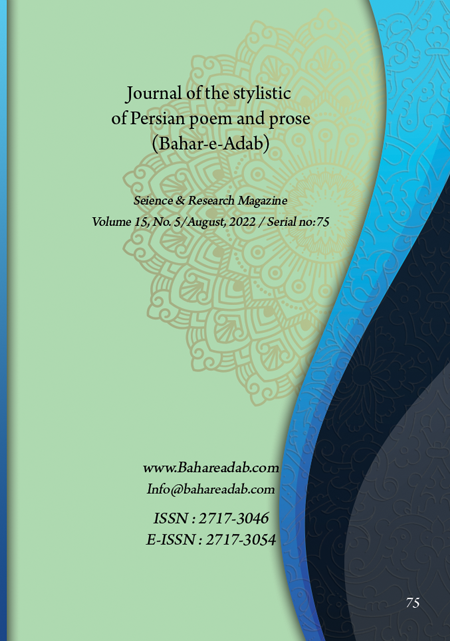- Count View : 298
- آدرس کوتاه شده مقاله: https://bahareadab.com/article_id/1313
- کد doi مقاله: Doi: 10.22034/bahareadab.2022 .15 .6416
Journal of the stylistic of Persian poem and prose
volume Number 15،
number In Volume 5،
،
issue Number 75
Stylistic analysis of women's social issues and superstitions against women in the contemporary novel (Relying on the intellectual style of Shahrnosh Parsipour and Moniro Ravanipour)
Mojgan Jahandar , Mazaher Nikkhah (Author in Charge), Hossein Khosravi
Abstract
BACKGROUND AND OBJECTIVES: In recent decades, stylistics research has led to a lot of growth. One of the branches and fields of stylistics is the study of female"s intellectual style and writing. In some women"s novels, even written by female writers, although the main characters are female, but with a negative attitude, they emerge in the form of a lower intellectual and cultural level than men, and in these novels, it has been talked about against women, with the production of superstitions and negative imagination. In this study, the main purpose is to investigate the negative feelings of contemporary female writers towards female personality in the intellectual style of Shahrnoush Parsipour Moniro Ravanipour.
METHODOLOGY: This research has been done in a descriptive-analytical manner using the method of intellectual stylistics. The samples were randomly selected from the two authors.
FINDINGS: The production of superstitions against women, the negative feelings of female characters towards each other in the novel, and the horizontal violence against each other, contrary to feminist theories, in order to strengthen the power of patriarchy in the novels in question, have been clearly considered by the authors.
CONCLUSION: In the novels of Shahrnoush Parsipour Moniro Ravanipour, the main characters are women but women have less education and social and cultural activities than men, and their most important concern is trivial issues. The intellectual level of some contemporary writers, including Shahrnoush Parsipour Moniro Ravanipour is influenced by the prevailing discourse, the same patriarchal discourse, in a way, regression about women can be found in their works
Keyword
Contemporary novel
, Women
, Production of superstitions
, Intellectual style
- Abbott, Pemlar and Wallace, Keller. (2001). Sociology of Women, translated by Manijeh Najm Iraqi, Tehran: Ney Publisher, p.324.
- Alikhani, Yousef. (2001). The Third Generation of Today's Fiction, Tehran: Markaz Publisher, p.58, 67-68.
- Bahrampour, Sha’ban Ali. (2000). An Introduction to Discourse Analysis in the Collection of Discourse and Discourse Analysis Articles, by: Mohammad Reza Tajik, Tehran: Farhang Goftman, p.50.
- Bert, Patrick. (2010). Sociological Theories, translated by Mohammad Khani, Tehran: New Event, p.72.
- Bourdieu, Pierre. (2015). Sociological Issues, translated by Pirooz Izadi, second edition, Tehran: Generation of the Sun, p.238.
- Chassler, Phyllis. (2010). Woman vs. Woman, translated by Saghar Aghili, Tehran: Liosa, p.24, 109.
- Emilia, Narcissians. (2004). Anthropology of Gender, Tehran: Afkar, p.67.
- Fakhrshafaei, Nahid. (2016). Antisemitism in Women-Centered Literature: A Comparative Study of Pride and Prejudice Novels by Jane Austen and I Turn Off the Lights by Zoya Pirzad, Journal of Comparative Literature, Faculty of Humanities, Shahid Bahonar University, Kerman, (22) 12, pp. 172 156.
- Gardner, William. (2007). War on the Family, translated and summarized by Masoumeh Mohammadi, Qom: Office of Women's Studies and Research.
- Hamm, Maggie and Gamble, Sara. (2003). Culture of Feminist Theories, translated by Firoozeh Mohajer et al., Tehran: Tose’e, p.323.
- Lloyd, Geneva. (2008). Masculine intellect; Masculinity and Femininity in Western Philosophy, translated by Mahboubeh and Mohammad Nabavi, Tehran: Agah, p.67.
- Mo’ayed Hekmat, Nahid. (2014). Cultural Capital: An Introduction to Pierre Bourdieu's Theoretical and Methodological Approach to Cultural Capital, Tehran: Institute of Humanities and Cultural Studies (electronic version).
- Moane, Geraldine. (2000). psychic Liberation: Feminist practices for transformation Among Irish woman, Pennsylvania stste university press.
- Mohseni Tabrizi, Alireza. (2000). A Study of Social Psychology of Employment and Work Culture, Tehran: Central Organization of Rural Cooperatives, p.18.
- Moshirzadeh, Homeira. (2004). Introduction to Women's Studies, Tehran: Ministry of Science, Research and Technology, p.485.
- Parsipour, Shahrnosh, Women without men, electronic version; www.zoon.ir
- Parsipour, Shahrnosh. (1992). Touba and the meaning of night, Fourth edition, Tehran: Alborz.
- Ravanipour, Moniro. (2001). Kenizo, fourth edition, Tehran: Niloufar.
- Ravanipour, Moniro. (2004). Syria Syria, Second Edition, Tehran: Ghesse.
- Rokni, Mohammad Mehdi. (1975). Algebra and Authority, Tehran: Third Generation, p.86.
- Sadeghi, Amir Hossein. (2008). Patriarchy in the Morning of Hangover Based on the Theories of Althusser, Research in Foreign Languages, No. 46, pp. 100-85.
- Sajjadi, Seyed Ali Mohammad and Hassani Jalilian, Mohammad Reza. (2008). Woman and descent; How to spread misconceptions about women in some Persian literary texts, Journal of Humanities, No. 57, pp. 186-161.
- Sattari, Reza and Haghighi, Marzieh. (2016). Deepening of patriarchal myths in Iranian marriages with Niranian, Quarterly Journal of Mystical and Mythological Literature, (42) 12, pp. 151-107.
- Soltani, Seyed Ali Asghar. (2005). Power, discourse and language, Tehran: Ney Publisher, p.94.
- Taheri, Qudratullah. (2009). Women's language and writing; Reality or illusion, Persian Language and Literature Quarterly, No. 42, pp. 107-87.
- Volk, René and Austin, Warren. (1994). Theory of Literature, translated by Zia Movahed and Parviz Mohajer, Tehran: Scientific and Cultural, p.113.

